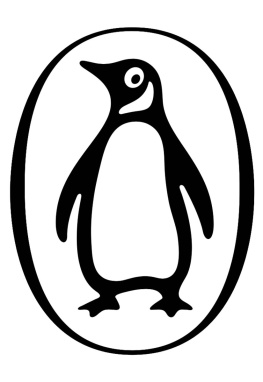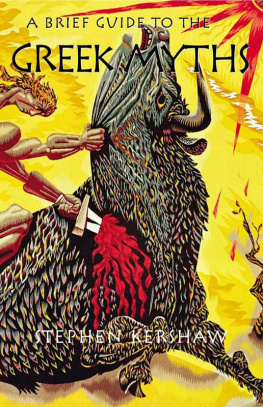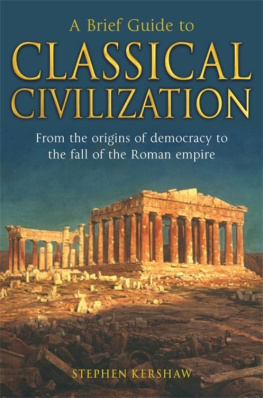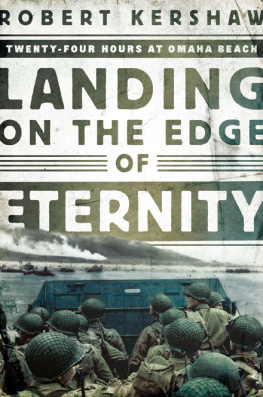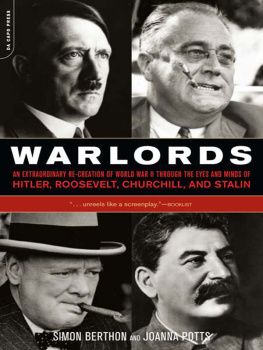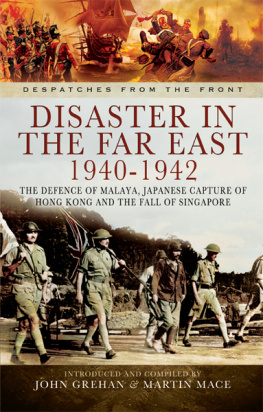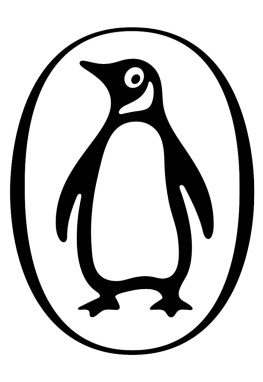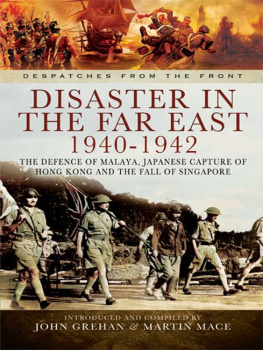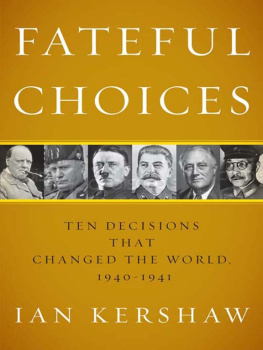IAN KERSHAW
Fateful Choices
Ten Decisions That Changed the World,
19401941
THE PENGUIN PRESS
NEW YORK
THE PENGUIN PRESS
Published by the Penguin Group
Penguin Group (USA) Inc., 375 Hudson Street, New York, New York 10014, U.S.A.
Penguin Group (Canada), 90 Eglinton Avenue East, Suite 700, Toronto, Ontario, Canada M4P 2Y3
(a division of Pearson Penguin Canada Inc.)
Penguin Books Ltd, 80 Strand, London WC2R 0RL, England
Penguin Ireland, 25 St. Stephens Green, Dublin 2, Ireland
(a division of Penguin Books Ltd)
Penguin Books Australia Ltd, 250 Camberwell Road, Camberwell, Victoria 3124, Australia
(a division of Pearson Australia Group Pty Ltd)
Penguin Books India Pvt Ltd, 11 Community Centre, Panchsheel Park, New Delhi110 017, India
Penguin Group (NZ), 67 Apollo Drive, Rosedale, North Shore 0745, Auckland, New Zealand
(a division of Pearson New Zealand Ltd.)
Penguin Books (South Africa) (Pty) Ltd, 24 Sturdee Avenue, Rosebank, Johannesburg 2196, South Africa
Penguin Books Ltd, Registered Offices:
80 Strand, London WC2R 0RL, England
First published in 2007 by The Penguin Press, a member of Penguin Group (USA) Inc.
Copyright Ian Kershaw, 2007
All rights reserved
ISBN: 978-1-1012-0237-1
Without limiting the rights under copyright reserved above, no part of this publication may be reproduced, stored in or introduced into a retrieval system, or transmitted, in any form or by any means (electronic, mechanical, photocopying, recording or otherwise), without the prior written permission of both the copyright owner and the above publisher of this book.
The scanning, uploading, and distribution of this book via the Internet or via any other means without the permission of the publisher is illegal and punishable by law. Please purchase only authorized electronic editions and do not participate in or encourage electronic piracy of copyrightable materials. Your support of the authors rights is appreciated.
Contents
1 London, Spring 1940
Great Britain Decides to Fight On
2 Berlin, Summer and Autumn 1940
Hitler Decides to Attack the Soviet Union
3 Tokyo, Summer and Autumn 1940
Japan Decides to Seize the Golden Opportunity
4 Rome, Summer and Autumn 1940
Mussolini Decides to Grab His Share
5 Washington, DC, Summer 1940Spring 1941
Roosevelt Decides to Lend a Hand
6 Moscow, SpringSummer 1941
Stalin Decides He Knows Best
7 Washington, DC, SummerAutumn 1941
Roosevelt Decides to Wage Undeclared War
8 Tokyo, Autumn 1941
Japan Decides to Go to War
9 Berlin, Autumn 1941
Hitler Decides to Declare War on the United States
10 Berlin/East Prussia, SummerAutumn 1941
Hitler Decides to Kill the Jews
List of Illustrations
Photographic acknowledgements are given in parentheses.
1 French infantry soldiers surrender, May 1940 (akg-images)
2 Allied troops, Dunkirk, 1940 (Alinari Archives)
3 Churchill with Lord Halifax in Downing Street, 1940 (akg-images/ullstein bild)
4 Grand Admiral Erich Raeder (akg-images)
5 Hitler and Franco at a French border station, October 1940 (akg-images/ullstein bild)
6 Molotov with Ribbentrop in Berlin, 1940 (akg-images)
7 Japanese Panzer tanks in southern China, 1941 (akg-images/ullstein bild)
8 Prince Konoe Fumimaro (akg-images)
9 The signing of the Tripartite Pact in Berlin, September 1940 (Alinari Archives)
10 Rally at the Italian entry into the war, June 1940 (akg-images)
11 Mussolini, Hitler, Ciano and Ribbentrop, October 1940 (akg-images/ullstein bild)
12 Italian artillery fire on Greek positions, March 1941 (akg-images/ullstein bild)
13 Roosevelt talking to Cordell Hull, 1940 (akg-images)
14 George C. Marshall and Henry L. Stimson (Time Life Pictures/Getty Images)
15 Stalin and Molotov (akg-images)
16 Captured Soviet soldiers, June 1941 (Roger-Viollet/Topfoto)
17 Stranded Soviet tanks, summer 1941 (Topfoto)
18 Franklin D. Roosevelt and Sir Winston Churchill aboard HMS Prince of Wales , August 1941 (AP/Empics)
19 General Tojo Hideki (Bettmann/Corbis)
20 Emperor Hirohito conducting a military review, December 1941 (akg-images)
21 Japanese air-raid on Pearl Harbor, 7 December 1941 (akg-images)
22 Nazi column advancing towards Moscow, August 1941 (Topfoto)
23 German Panzer tank near Moscow, 1941 (AP/Empics)
24 Hitler declares war on the USA, 11 December 1941 (akg-images)
25 Heinrich Himmler (Time Life Pictures/Getty Images)
26 Reinhard Heydrich (Corbis)
27 The Babi Yar massacre, Poland, September 1941 (Hulton Archive/Getty Images)
28 Men and women search among the dead after mass shootings in Lemberg, July 1941 (akg-images)
List of Maps
Map 1 Western Europe, 1940

Map 2 The Far East, 194041

Map 3 The Balkans, 194041

Map 4 The North Atlantic, 1941

Map 5 The Eastern front, 1941

Acknowledgements
A chance conversation in our kitchen gave me the idea for this book. Laurence Rees had come up to Manchester to discuss with me the concept for what would become the television series Auschwitz. The Nazis and the Final Solution the third series on which we had collaborated. While we were waiting for the kettle to boil, Laurence happened to mention that, were he a historian, he would want to write a book about the year 1941in his view, the most momentous year in modern history. The thought stuck. But it was obvious that the crucial events of 1941most obviously the German invasion of the Soviet Union (which triggered the rapid descent into full-scale genocide against the Jews), the Japanese attack on Pearl Harbor and the entry of the United States into the European warwere the logical consequence of a number of vital decisions that had flowed from Hitlers astonishing triumph in western Europe in spring 1940. A study of the interlocking key decisions by the leaders of the major powers during those extraordinary months between May 1940 and December 1941 started to take embryonic shape in my mind. So my first warm thanks are owing to Laurence for the initial impulse to undertake this book.
As usual, numerous other debts of gratitude have been incurred along the way and my brief acknowledgement here can only offer a cursory expression of my thanks. It is right, however, to single out the Leverhulme Foundation, for whose generosity I am once more deeply grateful. Much of the book was written during the final year of a wonderfully generous award which freed me from university commitments.
Finding my way through the less familiar territory that I had to traverse in the research and writing was greatly eased through being able to call upon the expertise of colleagues. I am extremely grateful to David Reynolds, who made very helpful comments on the typescript and shared with me some of his profound knowledge of Churchill and of British relations with the United States. Patrick Higgins kindly let me see his unpublished paper on R. A. Butler, and offered valuable comments on the May crisis of 1940. MacGregor Knox, beyond his own superb work on Fascist Italy, not only answered some detailed queries about the Italian armed forces but also, most generously, made available photocopies of the unpublished Roatta letter-diaries. The late Derek Watson (especially), Robert Davies, Robert Service, Moshe Lewin and, in Moscow, Sergei Slutsch were of enormous help on Stalin and the Soviet Union. Patrick Renshaw, Richard Carwardine and Hugh Wilford answered queries about the workings of the Roosevelt administration. In Tokyo Maurice Jenkins and Ms Owako Iwama were extraordinarily helpful in locating materials I required. I also received useful advice from Ken Ishida and, closer to home, Sue Townsend and Gordon Daniels. On more familiar terrain, Otto Dov Kulka in Jerusalem offered, as always, valuable reflections on the harrowing subject of the Nazi onslaught on the Jews. I profited, too, from a discussion about the emergence of the final solution with douard Husson, a younger French historian of Nazi Germany, whose fine work will surely soon become more widely known. I also benefited greatly from discussions, during a stay in Freiburg, with Gerhard Schreiber, Jrgen Frster and Manfred Kehrig. To all these colleagues and friends I offer my sincere thanks. Naturally, they have no responsibility for any errors or flaws in what I have written.


